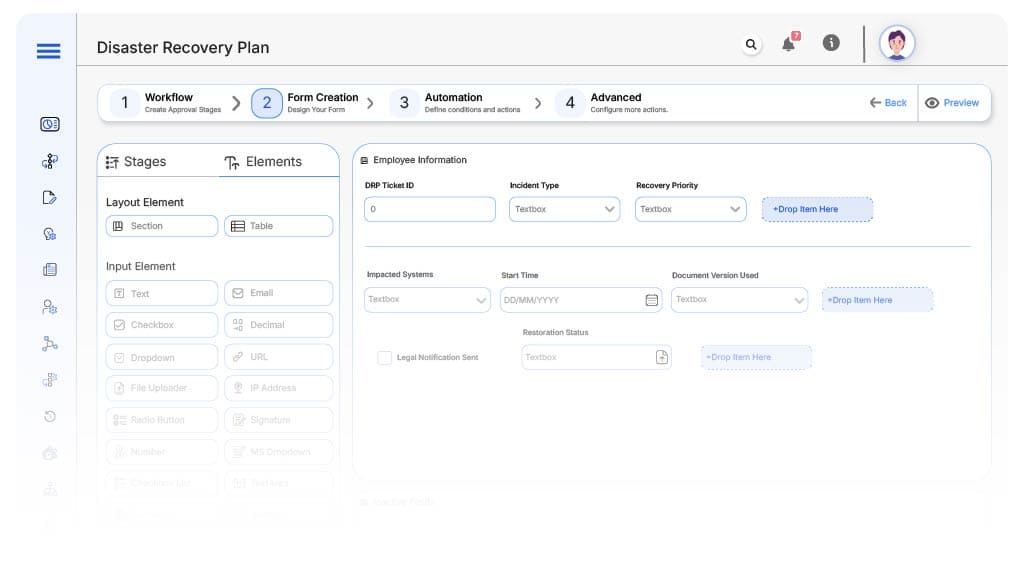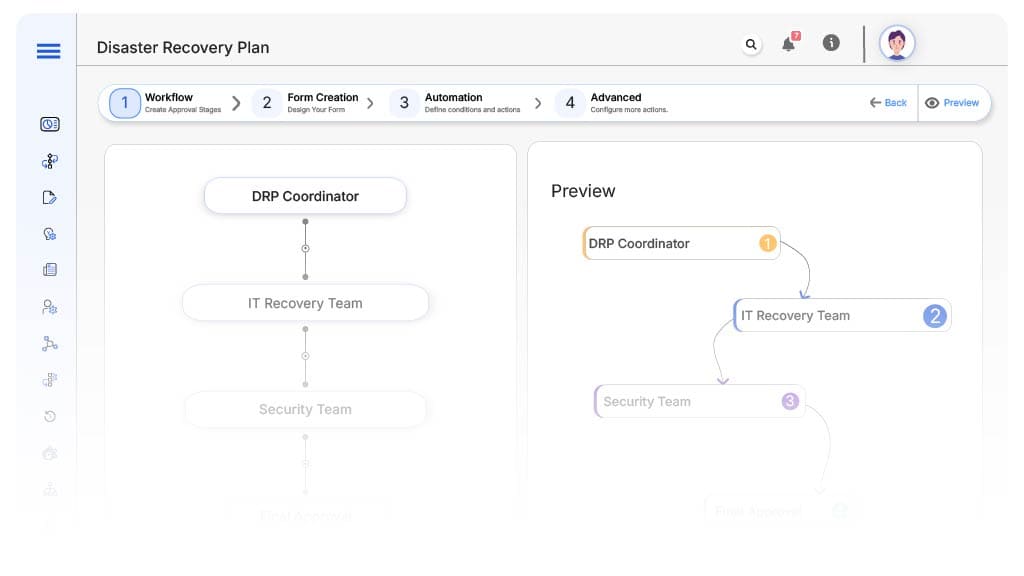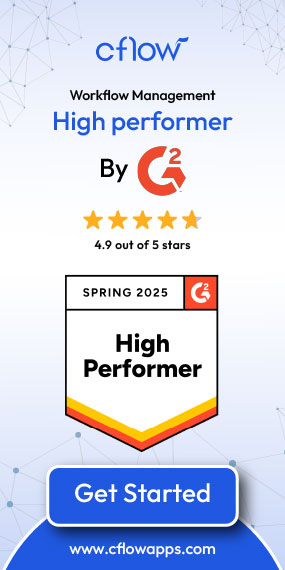- Cflow
- Disaster Recovery Plan Automation
Disaster Recovery Plan Automation

Clow Team

A Disaster Recovery Plan (DRP) ensures business continuity during major disruptions, be it natural disasters, cyberattacks, or system failures. However, without automation, DRP processes are fragmented, slow, and dependent on manual coordination across IT, Security, Legal, and Operations.
Missed notifications, lack of version control, delayed stakeholder response, and manual reporting severely reduce the effectiveness of recovery efforts. This guide explains how Cflow automates the Disaster Recovery Plan process, enabling real-time response, predefined escalation flows, centralized control, and full compliance
What Is a Disaster Recovery Plan?
A Disaster Recovery Plan is a documented workflow that outlines how an organization restores data, systems, and operations after a major disruption. It defines responsibilities, recovery steps, communication channels, and testing protocols.
Think of DRP as the emergency evacuation plan for your digital infrastructure. Just as a fire drill readies people for emergencies, a DRP prepares systems, teams, and data assets for rapid restoration under pressure.
According to IBM, companies with automated DRP systems recover 75% faster than those with manual plans.
Why Disaster Recovery Plan Automation Matters
Faster Recovery Time
Fewer Compliance Risks
Clear Accountability
Multi-System Visibility
Key Benefits of Automating Disaster Recovery Plans with Cflow
- Centralized Recovery Workflow: Cflow consolidates recovery steps from incident detection to system restoration into one cohesive dashboard. IT, compliance, and security teams receive their specific tasks, timelines, and escalation alerts, ensuring clarity and control during high-stress incidents. Each step is logged and visible in real-time, providing leadership with a complete view of the recovery progress.
- Predefined Escalation Paths: Cflow lets you design step-by-step escalation routes. If a team doesn’t act within the recovery window, Cflow automatically escalates tasks to higher roles, ensuring continuity doesn’t stall due to inaction. Escalation rules can be customized based on incident severity, SLA levels, or department priorities.
- Automated Testing Schedules: Instead of manually reminding teams to run recovery drills, Cflow auto-triggers scheduled tests. Reports are logged, deviations flagged, and DRP readiness status is visible to executives. Recurring test plans ensure every team remains DRP-ready without constant follow-up from management.
- Role-Based Task Distribution: Tasks like backup verification, failover switch, legal notification, and customer updates are routed to respective stakeholders. Every user sees only their action items, reducing confusion and error. Task dependencies are clearly mapped so teams know when to act and whom to coordinate with.
- Real-Time Compliance Reporting: All steps from initiating recovery to restoring data are timestamped and stored. Whether it’s HIPAA, ISO 27001, or NIST, Cflow’s audit trail supports compliance with customizable reporting dashboards.
Exportable logs make it easier to share reports with auditors or regulatory bodies instantly. - Version-Controlled DRP Documents: Cflow hosts the latest DRP versions and restricts outdated versions from being accessed. Approval logs ensure only authorized updates are published, and rollback options are available if needed. Users are always working with the most current plan, reducing risk during live incidents.
- Mobile and Offline Access: Even if systems are partially down, recovery tasks can be accessed via mobile or offline mode. This ensures that field responders or remote teams can still coordinate recovery actions. Offline updates sync automatically once connectivity is restored, preventing loss of critical data
Get the best value for money with Cflow
User Roles & Permissions
DRP Coordinator
- Responsibilities: Initiate recovery plan, assign teams, monitor completion.
- Cflow Permission Level: Admin
- Mapping: “Recovery Admins” group
IT Recovery Team
- Responsibilities: Server backup, application failover, network restoration.
- Cflow Permission Level: Task Owner
- Mapping: “IT Team” group
Security Team
- Responsibilities: Assess breach, patch vulnerabilities, restore access controls.
- Cflow Permission Level: Task Owner
- Mapping: “Security Group”
Compliance Officer
- Responsibilities: Ensure regulatory alignment and document control.
- Cflow Permission Level: Approve/Reject
- Mapping: “Compliance” group
Operations Lead
- Responsibilities: Oversee resumption of business processes and facilities.
- Cflow Permission Level: Task Owner
- Mapping: “Operations” group
Executive Sponsor
- Responsibilities: Final approval, issue executive updates, and sign-off.
- Cflow Permission Level: Approve/Reject
- Mapping: “Leadership” group
Discover why teams choose Cflow
Form Design & Field Definitions

Field Label: DRP Ticket ID
- Type: Autonumber
- Auto-Populate: Generated on submission.
Field Label: Incident Type
- Type: Dropdown (Data breach, Natural Disaster, Outage, Other)
- Logic/Rules: Drives task routing
Field Label: Recovery Priority
- Type: Dropdown (High, Medium, Low)
- Logic/Rules: Sets escalation timelines
Field Label: Impacted Systems
- Type: Multi-select (ERP, CRM, Email, Database, etc.)
- Logic/Rules: Assigns recovery owners
Field Label: Start Time
- Type: Date-Time Picker
- Logic/Rules: Used in RTO/RPO calculations
Field Label: Document Version Used
- Type: Dropdown
- Logic/Rules: Version check enforcement
Field Label: Legal Notification Sent
- Type: Checkbox
- Logic/Rules: Must be checked before proceeding
Field Label: Restoration Status
- Type: Dropdown (Low, Medium, High)
- Logic/Rules: Mandatory for InfoSec review
Field Label: Final Review Notes
- Type: Text Area
- Logic/Rules: Required for closure
Transform your Workflow with AI fusion
Approval Flow & Routing Logic

Submission → DRP Coordinator
- Status Name: Plan Initiated
- Notification Template: “DRP initiated for {Incident Type}. Assigning teams.”
- On Approve: Routes to IT, Security, and Compliance teams simultaneously.
DRP Coordinator → IT Recovery Team
- Status Name: IT Recovery Tasks
- Notification Template: “Restore impacted systems: {Impacted Systems}.”
- Escalation: Reminder after 2 hours.
- On Complete: Moves to Security.
IT → Security Team
- Status Name: Security Remediation
- Notification Template: “Validate breach resolution and reset credentials.”
- Escalation: Reminder after 3 hours.
- On Complete: Moves to Compliance.
Security → Compliance Officer
- Status Name: Compliance Checks
- Notification Template: “Confirm documentation and notify regulatory bodies.”
- Escalation: Reminder after 1 day.
- On Complete: Moves to Operations.
Compliance → Operations Lead
- Status Name: Ops Resumption
- Notification Template: “Confirm business operations and internal updates.”
- Escalation: Reminder after 1 day.
- On Complete: Moves to Executive.
Operations → Executive Sponsor
- Status Name: Final Sign-Off
- Notification Template: “All DRP steps complete. Approve closure.”
- On Approve: Moves to DRP Closure.
- Escalation: Notify CIO after 1 day if pending.
Final → DRP Closure
- Status Name: DRP Closed
- Notification Template: “Disaster Recovery Plan process completed and archived for compliance reference.
Transform your AI-powered approvals
Implementation Steps in Cflow
Create a new workflow
Design the form
Set up User Roles/Groups
Build the process flow diagram
Add notifications
Configure logic
Activate
Test with a sample request
Train
Go live
Example Journey: Server Outage DRP
FAQ's
Unleash the full potential of your AI-powered Workflow

